Abstract
The nematode parasites that cause human lymphatic filariasis survive for long periods in their vascular habitats despite continual exposure to host cells. Platelets do not adhere to blood-borne microfilariae, and thrombo-occlusive phenomena are not observed in patients with circulating microfilariae. We studied the ability of microfilariae to inhibit human platelet aggregation in vitro. Brugia malayi microfilariae incubated with human platelets caused dose-dependent inhibition of agonist-induced platelet aggregation, thromboxane generation, and serotonin release. As few as one microfilaria per 10(4) platelets completely inhibited aggregation of platelets induced by thrombin, collagen, arachidonic acid, or ionophore A23187. Microfilariae also inhibited aggregation of platelets in platelet-rich plasma stimulated by ADP, compound U46619, or platelet-activating factor. The inhibition required intimate proximity but not direct contact between parasites and platelets, and was mediated by parasite-derived soluble factors of low (less than 1,000 Mr) molecular weight that were labile in aqueous media and caused an elevation of platelet cAMP. Prior treatment of microfilariae with pharmacologic inhibitors of cyclooxygenase decreased both parasite release of prostacyclin and PGE2 and microfilarial inhibition of platelet aggregation. These results indicate that microfilariae inhibit platelet aggregation, via mechanisms that may include the elaboration of anti-aggregatory eicosanoids.
Full text
PDF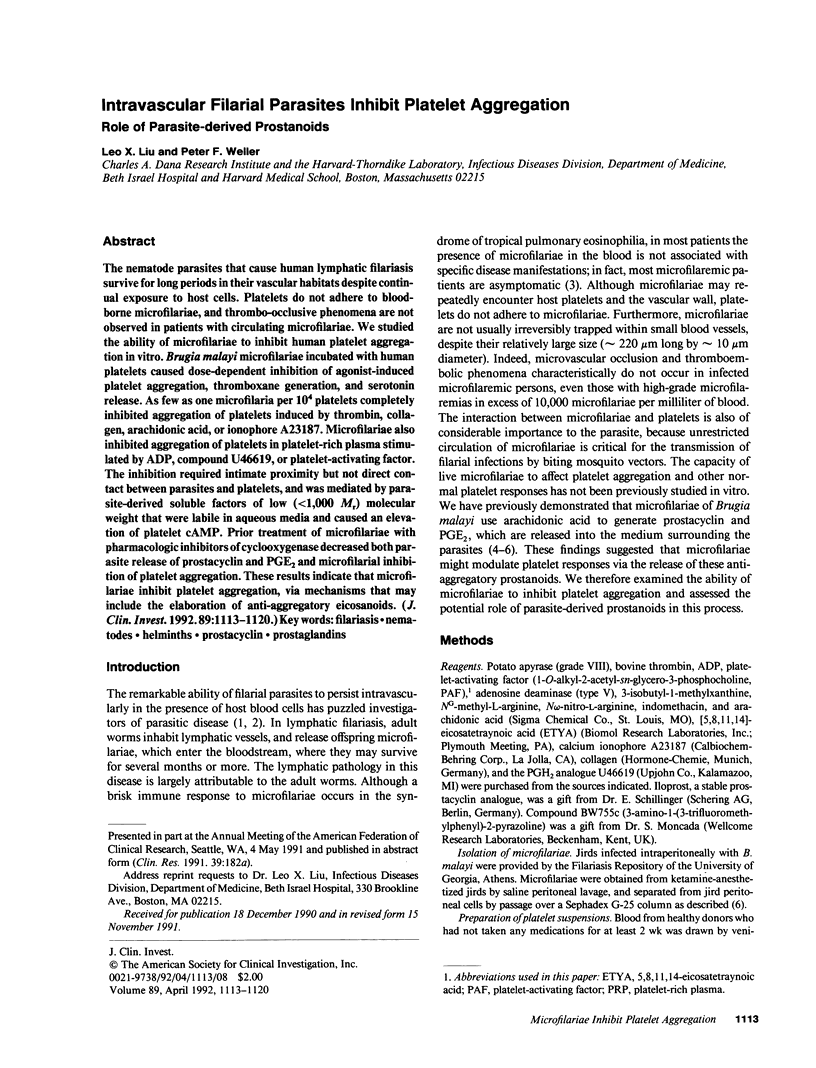
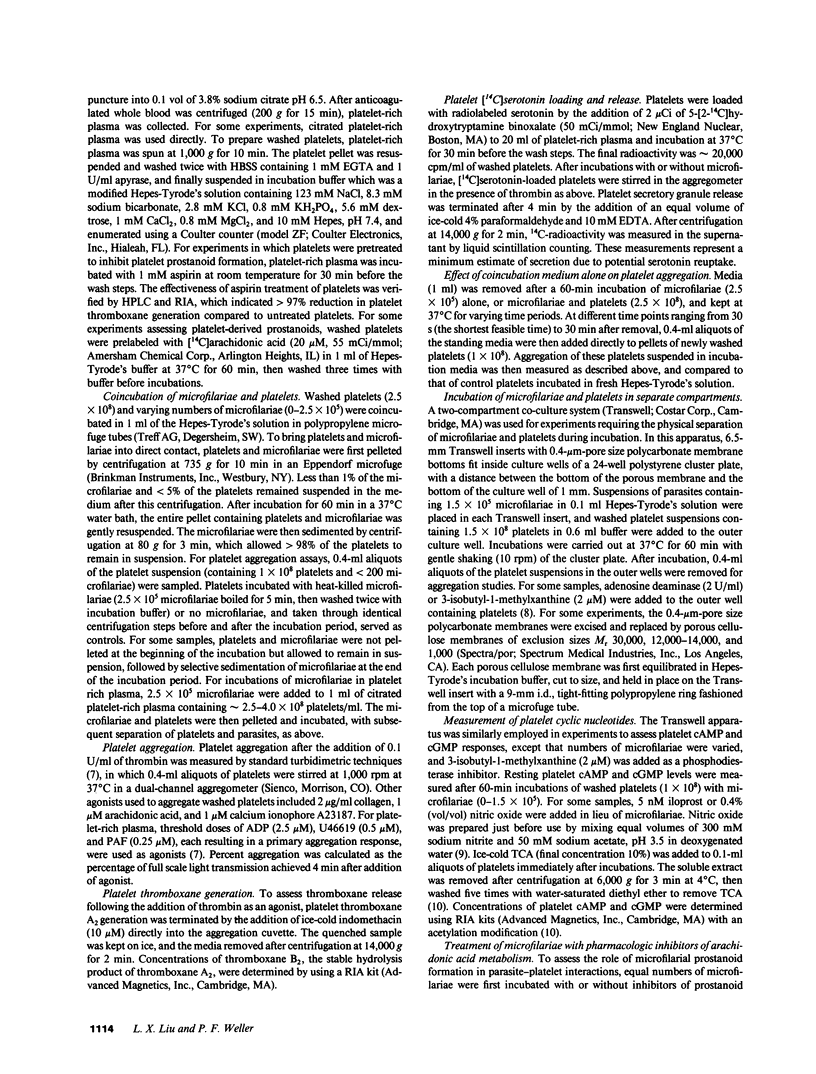

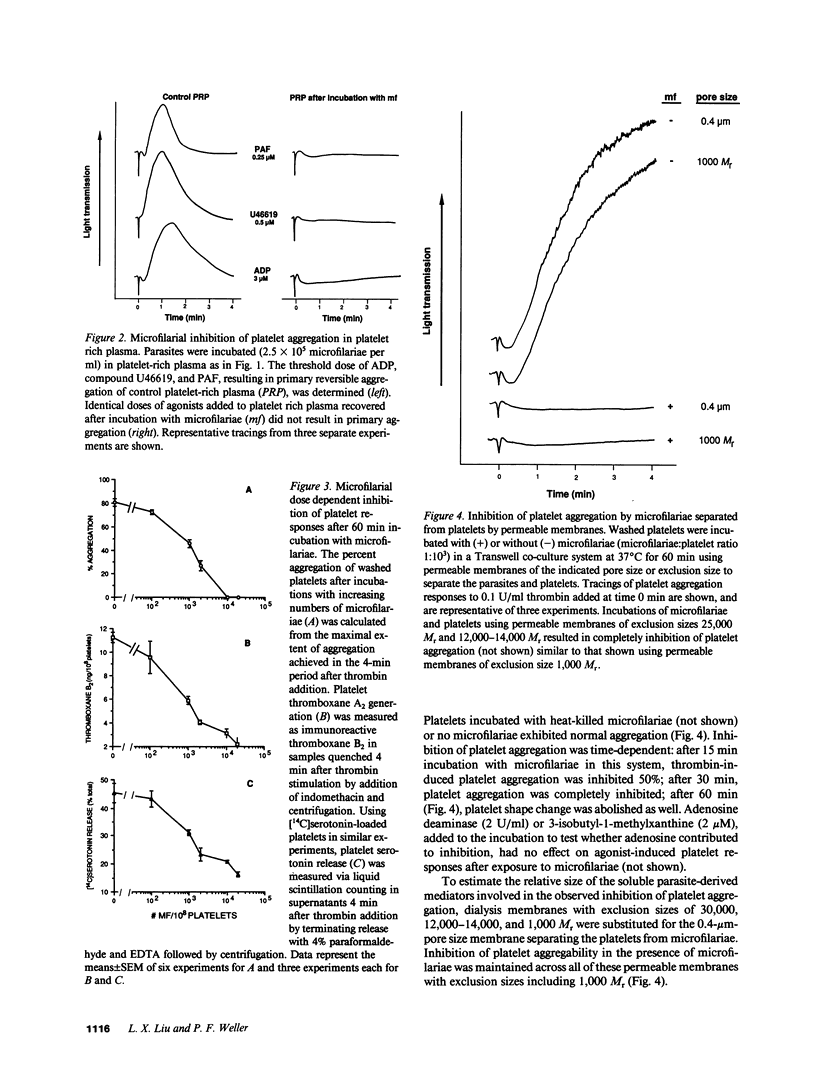
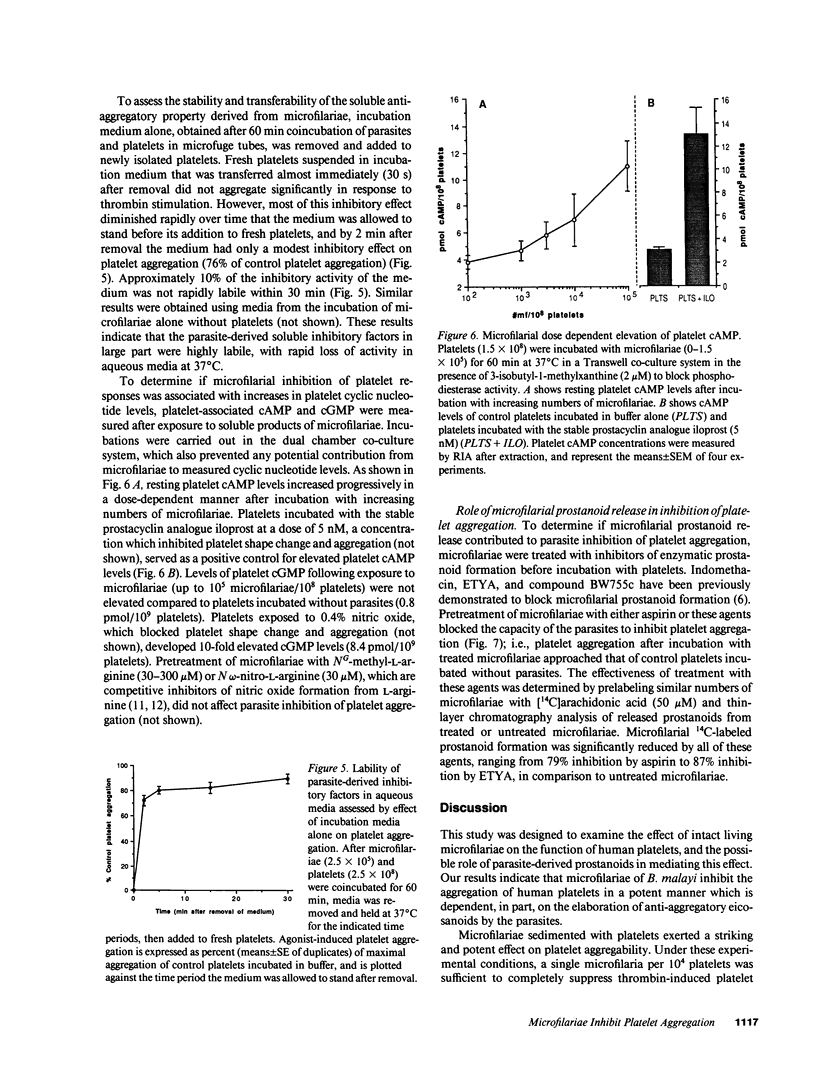
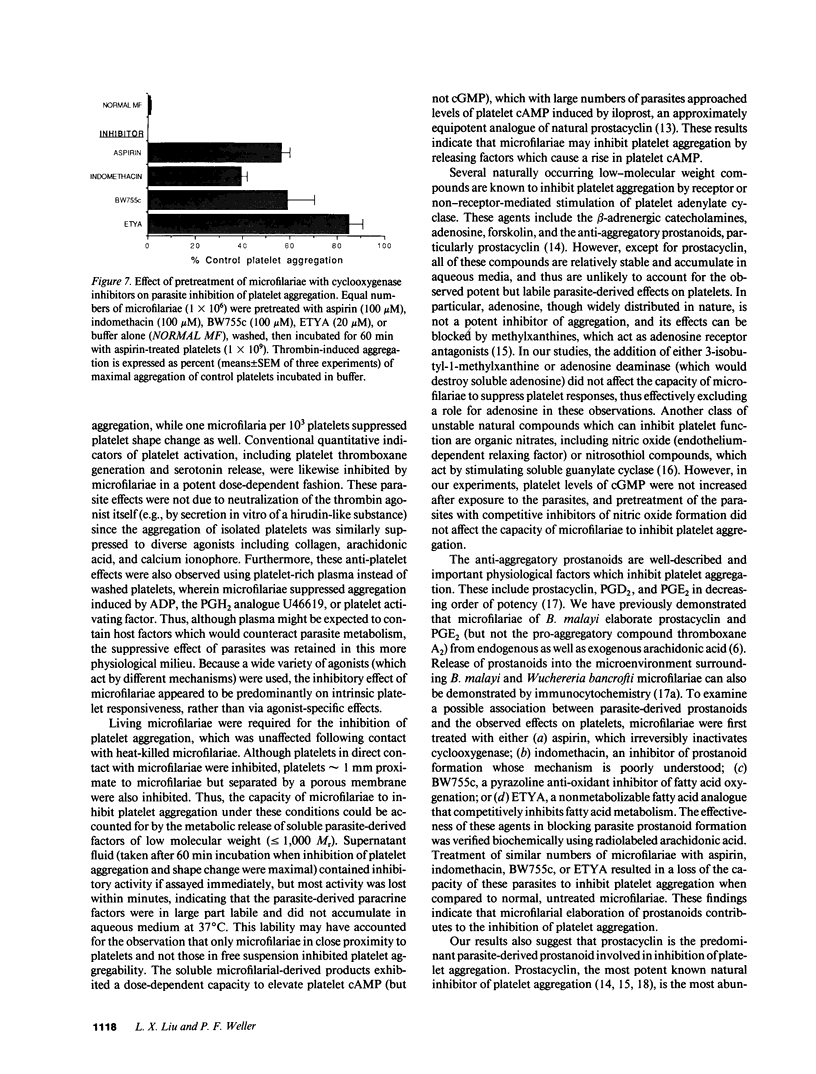
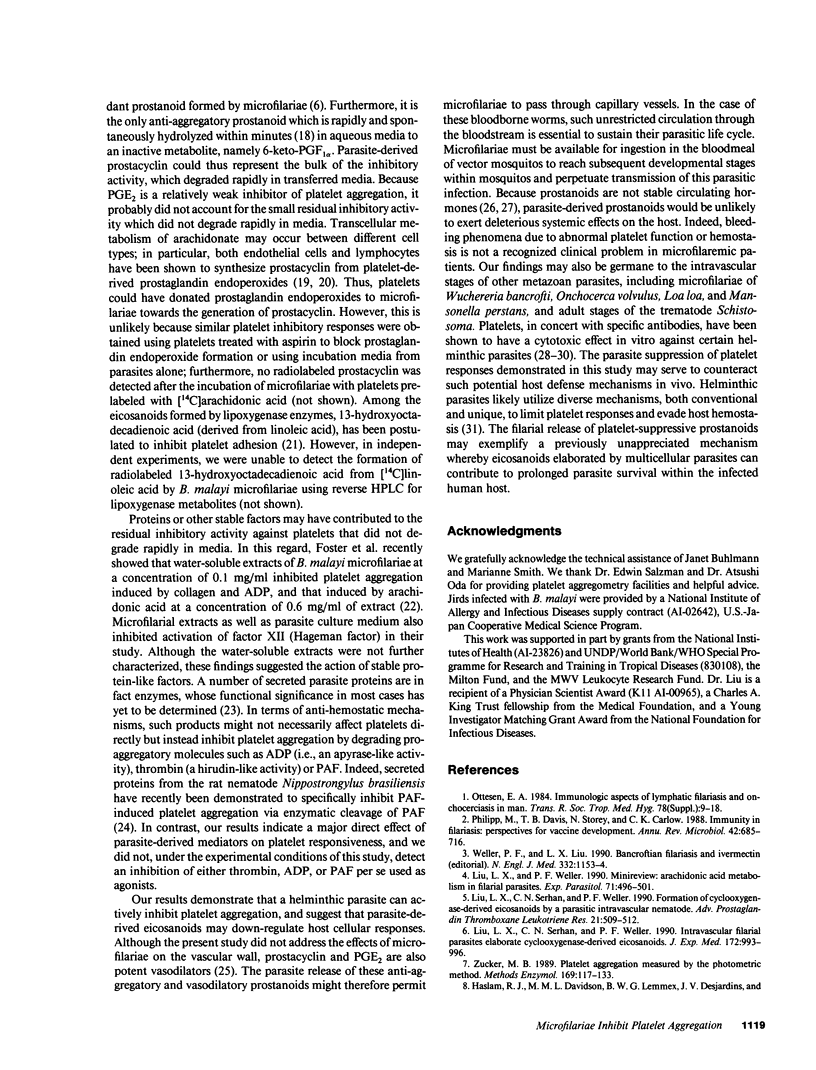
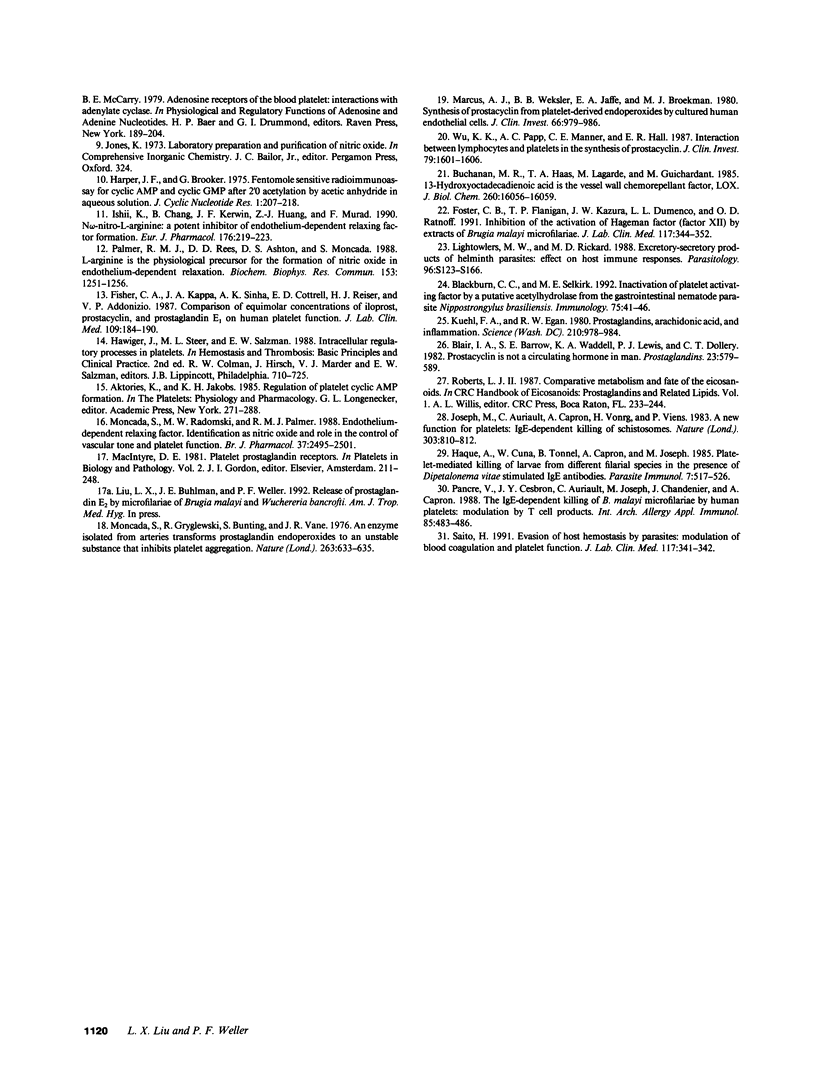
Images in this article
Selected References
These references are in PubMed. This may not be the complete list of references from this article.
- Blackburn C. C., Selkirk M. E. Inactivation of platelet-activating factor by a putative acetylhydrolase from the gastrointestinal nematode parasite Nippostrongylus brasiliensis. Immunology. 1992 Jan;75(1):41–46. [PMC free article] [PubMed] [Google Scholar]
- Blair I. A., Barrow S. E., Waddell K. A., Lewis P. J., Dollery C. T. Prostacyclin is not a circulating hormone in man. Prostaglandins. 1982 Apr;23(4):579–589. doi: 10.1016/0090-6980(82)90118-6. [DOI] [PubMed] [Google Scholar]
- Buchanan M. R., Haas T. A., Lagarde M., Guichardant M. 13-Hydroxyoctadecadienoic acid is the vessel wall chemorepellant factor, LOX. J Biol Chem. 1985 Dec 25;260(30):16056–16059. [PubMed] [Google Scholar]
- Fisher C. A., Kappa J. R., Sinha A. K., Cottrell E. D., Reiser H. J., Addonizio V. P. Comparison of equimolar concentrations of iloprost, prostacyclin, and prostaglandin E1 on human platelet function. J Lab Clin Med. 1987 Feb;109(2):184–190. [PubMed] [Google Scholar]
- Foster C. B., Flanigan T. P., Kazura J. W., Dumenco L. L., Ratnoff O. D. Inhibition of the activation of Hageman factor (factor XII) and of platelet aggregation by extracts of Brugia malayi microfilariae. J Lab Clin Med. 1991 May;117(5):344–352. [PubMed] [Google Scholar]
- Haque A., Cuna W., Bonnel B., Capron A., Joseph M. Platelet mediated killing of larvae from different filarial species in the presence of Dipetalonema viteae stimulated IgE antibodies. Parasite Immunol. 1985 Sep;7(5):517–526. doi: 10.1111/j.1365-3024.1985.tb00096.x. [DOI] [PubMed] [Google Scholar]
- Harper J. F., Brooker G. Femtomole sensitive radioimmunoassay for cyclic AMP and cyclic GMP after 2'0 acetylation by acetic anhydride in aqueous solution. J Cyclic Nucleotide Res. 1975;1(4):207–218. [PubMed] [Google Scholar]
- Ishii K., Chang B., Kerwin J. F., Jr, Huang Z. J., Murad F. N omega-nitro-L-arginine: a potent inhibitor of endothelium-derived relaxing factor formation. Eur J Pharmacol. 1990 Feb 6;176(2):219–223. doi: 10.1016/0014-2999(90)90531-a. [DOI] [PubMed] [Google Scholar]
- Joseph M., Auriault C., Capron A., Vorng H., Viens P. A new function for platelets: IgE-dependent killing of schistosomes. Nature. 1983 Jun 30;303(5920):810–812. doi: 10.1038/303810a0. [DOI] [PubMed] [Google Scholar]
- Kuehl F. A., Jr, Egan R. W. Prostaglandins, arachidonic acid, and inflammation. Science. 1980 Nov 28;210(4473):978–984. doi: 10.1126/science.6254151. [DOI] [PubMed] [Google Scholar]
- Lightowlers M. W., Rickard M. D. Excretory-secretory products of helminth parasites: effects on host immune responses. Parasitology. 1988;96 (Suppl):S123–S166. doi: 10.1017/s0031182000086017. [DOI] [PubMed] [Google Scholar]
- Liu L. X., Serhan C. N., Weller P. F. Intravascular filarial parasites elaborate cyclooxygenase-derived eicosanoids. J Exp Med. 1990 Sep 1;172(3):993–996. doi: 10.1084/jem.172.3.993. [DOI] [PMC free article] [PubMed] [Google Scholar]
- Liu L. X., Weller P. F. Arachidonic acid metabolism in filarial parasites. Exp Parasitol. 1990 Nov;71(4):496–501. doi: 10.1016/0014-4894(90)90076-o. [DOI] [PubMed] [Google Scholar]
- Marcus A. J., Weksler B. B., Jaffe E. A., Broekman M. J. Synthesis of prostacyclin from platelet-derived endoperoxides by cultured human endothelial cells. J Clin Invest. 1980 Nov;66(5):979–986. doi: 10.1172/JCI109967. [DOI] [PMC free article] [PubMed] [Google Scholar]
- Moncada S., Radomski M. W., Palmer R. M. Endothelium-derived relaxing factor. Identification as nitric oxide and role in the control of vascular tone and platelet function. Biochem Pharmacol. 1988 Jul 1;37(13):2495–2501. doi: 10.1016/0006-2952(88)90236-5. [DOI] [PubMed] [Google Scholar]
- Ottesen E. A. Immunological aspects of lymphatic filariasis and onchocerciasis in man. Trans R Soc Trop Med Hyg. 1984;78 (Suppl):9–18. doi: 10.1016/0035-9203(84)90309-2. [DOI] [PubMed] [Google Scholar]
- Palmer R. M., Rees D. D., Ashton D. S., Moncada S. L-arginine is the physiological precursor for the formation of nitric oxide in endothelium-dependent relaxation. Biochem Biophys Res Commun. 1988 Jun 30;153(3):1251–1256. doi: 10.1016/s0006-291x(88)81362-7. [DOI] [PubMed] [Google Scholar]
- Pancré V., Cesbron J. Y., Auriault C., Joseph M., Chandenier J., Capron A. IgE-dependent killing of Brugia malayi microfilariae by human platelets and its modulation by T cell products. Int Arch Allergy Appl Immunol. 1988;85(4):483–486. doi: 10.1159/000234556. [DOI] [PubMed] [Google Scholar]
- Philipp M., Davis T. B., Storey N., Carlow C. K. Immunity in filariasis: perspectives for vaccine development. Annu Rev Microbiol. 1988;42:685–716. doi: 10.1146/annurev.mi.42.100188.003345. [DOI] [PubMed] [Google Scholar]
- Saito H. Evasion of host hemostasis by parasites: modulation of blood coagulation and platelet function. J Lab Clin Med. 1991 May;117(5):341–342. [PubMed] [Google Scholar]
- Weller P. F., Liu L. X. Bancroftian filariasis and ivermectin. N Engl J Med. 1990 Apr 19;322(16):1153–1154. doi: 10.1056/NEJM199004193221611. [DOI] [PubMed] [Google Scholar]
- Wu K. K., Papp A. C., Manner C. E., Hall E. R. Interaction between lymphocytes and platelets in the synthesis of prostacyclin. J Clin Invest. 1987 Jun;79(6):1601–1606. doi: 10.1172/JCI112995. [DOI] [PMC free article] [PubMed] [Google Scholar]
- Zucker M. B. Platelet aggregation measured by the photometric method. Methods Enzymol. 1989;169:117–133. doi: 10.1016/0076-6879(89)69054-4. [DOI] [PubMed] [Google Scholar]




